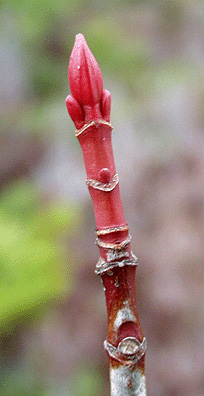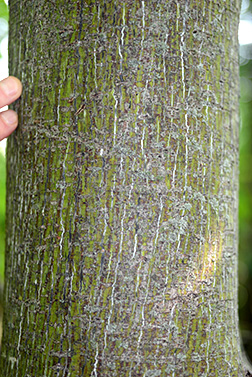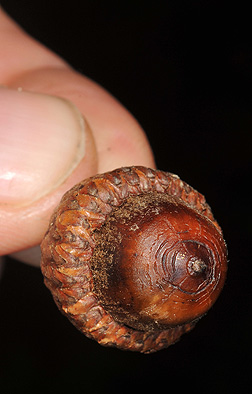VT Dendro Lab Notes
striped maple
Aceraceae
Acer pensylvanicum
Leaf: Opposite, simple, orbicular, 5 to 8 inches long, 3-lobed (resembles a goose foot), serrated margin; green above and paler below.
Flower: Species is dioecious; yellow-green, bellshaped, 1/4 inch long, appear in long, hanging slender clusters in late spring.
Fruit: Paired, wide-spreading samaras, 3/4 to 1 inch long, in hanging clusters, ripen in late summer and early fall.
Twig: Moderately stout, green changing to red or reddish brown, smooth; reddish buds narrowly ovoid, stalked, valvate.
Bark: When young, smooth gray-green with prominent white lengthwise stripes, older bark becomes reddish brown.
Form: Small tree or large shrub up to 30 feet tall.







Notes:
VT Dendro Lab Notes
scarlet oak
Fagaceae
Quercus coccinea
Leaf: Alternate, simple, 3 to 7 inches long, oval in shape with very deep sinuses and bristle-tipped lobes, shiny green above, paler and generally hairless below but may have tufts in vein axils.
Flower: Species is monoecious; males are borne on slender yellow-green catkins; females are borne on very short axilliary spikes, both appear with the leaves in spring.
Fruit: Acorns are 1/2 to 1 inch long, with the cap covering 1/2 of the nut, cap scales are shiny, somewhat resembling a varnished black oak cap, scales on edges of cap generally not loose; the tip of the acorn may have concentric rings or fine cracks; maturing in two years and ripening in the fall.
Twig: Moderately stout, red-brown with multiple terminal buds; buds reddish brown, plump, pointed, slightly angled, and covered with a light colored pubescence on the top half.
Bark: On young trees, gray-brown, with smooth streaks; later becoming darker and developing irregular broad ridges and narrow furrows especially near the base.
Form: A medium size tree reaching up to 80 feet tall with generally poor form, irregular crown, and many dead branches. A butt-swell is often noticeable, and often is useful in identification.







Notes:
VT Dendro Lab Notes
witch-hazel
Hamamelidaceae
Hamamelis virginiana
Leaf: Alternate, simple, broadly ovate to obovate, 3 to 6 inches long, inequilateral, wavy margin (nearly dentate), petiole pubescent, dark green above and paler below.
Flower: Species is monoecious; bright yellow, with 4, 1/2 to 3/4 inch long, very slender petals (look like yellow spiders on plant), appearing in mid to late fall.
Fruit: Woody, brown capsule, 1/2 inch long and nearly as wide, containing two shiny black seeds, 1/4 inch long, seeds are forcibly discharged when capsule splits open. Maturing in late summer and old capsules are persistent.
Twig: Slender, light brown, fine pubescence; light brown vegetative buds (1/3 inch) are stalked and lack scales (resemble a deer foot, they are actually a tiny folded leaf); flower buds are small, round and occur in tight clusters from short stalks.
Bark: Smooth, gray to gray-brown even on very old stems.
Form: A small tree or shrub with arching branches, usually growing in dense multi-stemmed clumps reaching up to 20 feet tall.







Notes:
VT Dendro Lab Notes
sweetfern
Myricaceae
Comptonia peregrina
Leaf: Alternate, simple leaf, linear, 2 to 4 inches long, 1/3 to 1/2 inch wide, coarsely irregularly toothed, tight arrangement on twigs causes them to resemble ferns, dark green above, a bit paler below, very fragrant.
Flower: Species is monoecious; females short rounded catkin with reddish bracts, males elongated, yellow-green catkins in clusters at twig ends, appear in spring.
Fruit: Round, bur-like cluster of ovoid nutlets, brown when mature in late summer.
Twig: Slender, gray-brown, fuzzy; buds round, plump, male catkins present in the winter, resin dots often present.
Bark: Smooth, shiny reddish brown, heavily lenticeled.
Form: A small, densely branched shrub reaching 2 to 4 feet in height, spreads with rhizomes.







Notes:
VT Dendro Lab Notes
pitch pine
Pinaceae
Pinus rigida
Leaf: Evergreen needles, 2 1/2 to 5 inches long, with three twisted needles per fascicle, yellow-green to green.
Flower: Species is monoecious; males cylindrical, red to yellow, in large clusters at twig tips; females yellow to red, with small, curved scales.
Fruit: Cones are ovoid, 2 to 4 inches long, light brown in color; umbo is armed with a short, stout prickle; cones are often persistent for many years; maturing in fall.
Twig: Orange-brown and moderately stout; buds narrowly ovoid, light gray-brown.
Bark: Dark and scaly when young, developing red-brown or yellow-brown thick flat plates with deep furrows; sprouts of needles may be present.
Form: Extremely variable; short and poorly formed on poor sites, but can be a straight, medium sized tree reaching 80 feet tall on better sites; epicormic sprouting is common.







Notes:
VT Dendro Lab Notes
eastern hemlock
Pinaceae
Tsuga canadensis
Leaf: Evergreen, flat, single needles, 1/2 inch long, tapering to a dull point, primarily two-ranked, shiny dark green above, 2 lines of white stomata below.
Flower: Species is monoecious; males yellow, small, round; females light green at branch tips.
Fruit: Ovoid light brown cone, 3/4 inch long with rounded, entire scales, maturing in early fall.
Twig: Slender, gray-brown in color; buds are very small.
Bark: Initially gray-brown and smooth then turning scaly; older trees are red-brown with wide ridges and furrows; when cut or broken, purple streaks are obvious.
Form: A medium sized tree with a dense, conical crown, fine branches and a drooping terminal shoot reaching up to 80 feet tall, typically a poor natural pruner.







Notes:
VT Dendro Lab Notes
downy serviceberry
Rosaceae
Amelanchier arborea
Leaf: Alternate, simple, ovate, 1 1/2 to 3 inches long, pinnately-veined, finely serrate, green above and paler below, may be pubescent below, particularly when young.
Flower: Showy with 5 long (1/2 inch) strap-like white petals, occuring in elongated, drooping bunches, appear in spring just before or with the leaves.
Fruit: Red to purple round berry-like pome, 1/4 to 3/8 inch in diameter, in small hanging clusters, ripen in early to mid summer. The fruits are edible and may be the best kept secret in the woods.
Twig: Slender, flexible, red-brown to gray in color,a few lighter scattered lenticels, may be covered with fine hairs when young; buds are long pointed, up to 1/2 inch long, covered with only a few scales, usually with hairy margins, light yellow-green to red in color, often slightly hooking around twigs.
Bark: Smooth when young, ashy-gray with darker stripes; later becoming rough with long vertical splits and furrows.
Form: A shrub or small tree up to 40 feet (occasionally much larger) with a narrow crown.







Notes:
VT Dendro Lab Notes
Alleghany blackberry
Rosaceae
Rubus allegheniensis
Leaf: Alternate, palmately compound, 3 to 5 inches long and wide, 3 to 7 leaflets (mostly 5), ovate to oval leaflets, serrated margins, prickles on petiole, dark green above and much paler below.
Flower: Species is monoecious; showy white flowers (one inch across) with 5 petals, larger and persisting longer than black raspberry.
Fruit: Juicy, black multiple of drupes, up to 1 inch long, ripens in late summer. When picked, the fruit does not separate from its core.
Twig: Stout, strongly angled canes with large hooked prickles, dull reddish brown, lacking glaucous bloom. Cane tips do not root.
Bark: Similar to twig but darkens with age.
Form: Sprawling, arching canes that form dense thickets, often well over head-high, particularly when supported.







Notes:























































